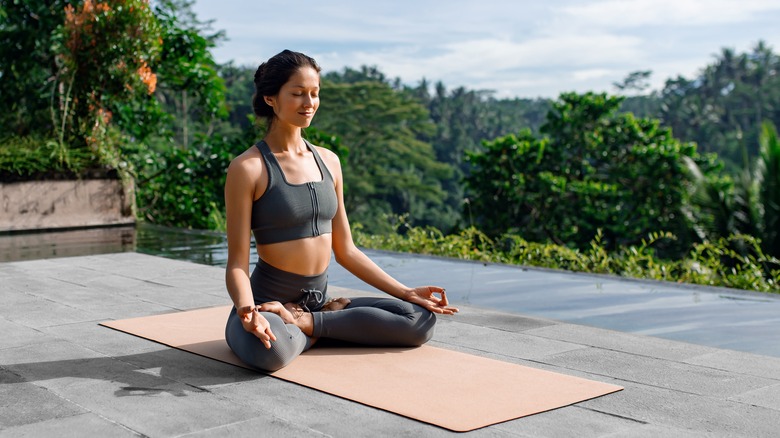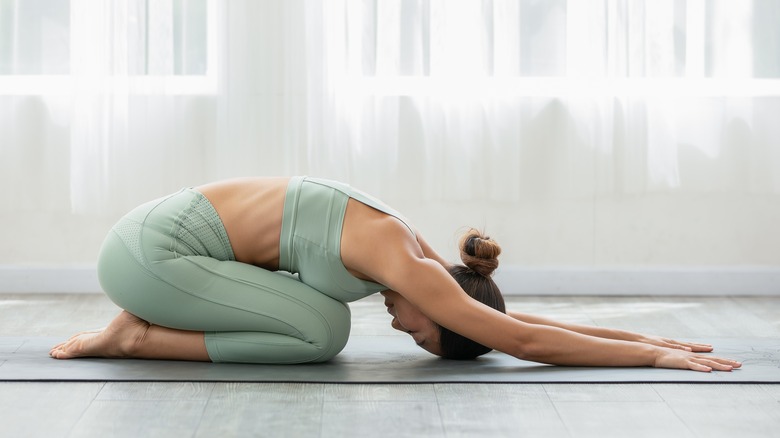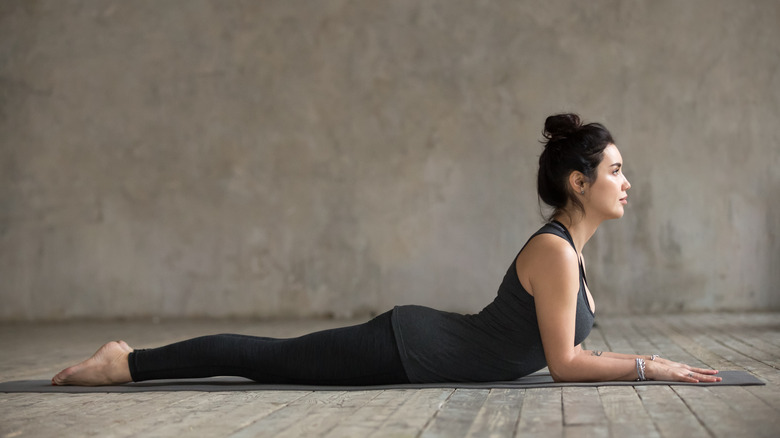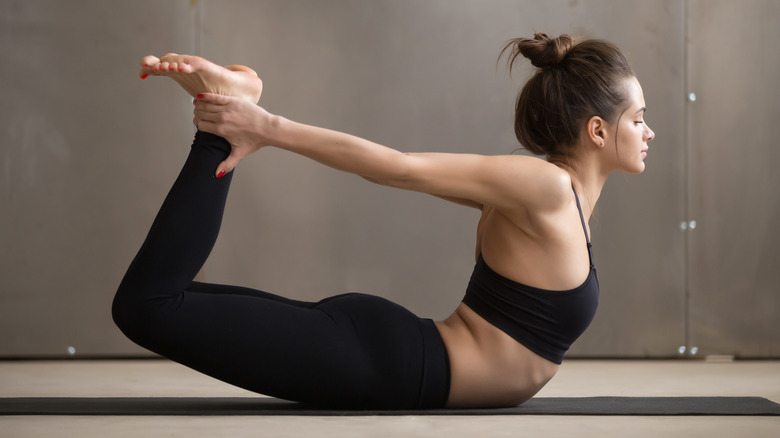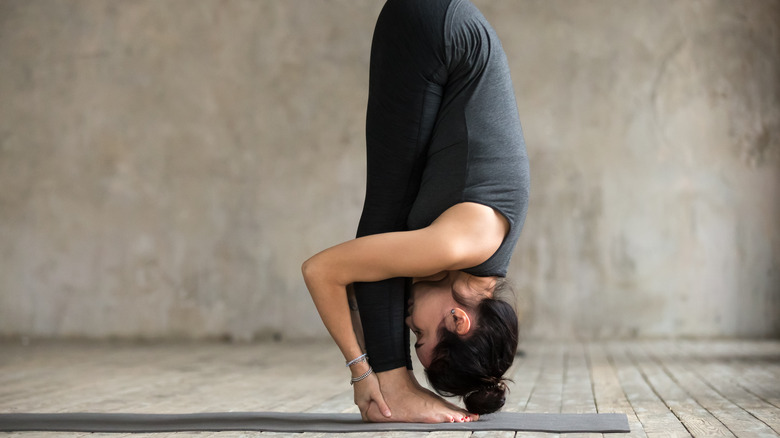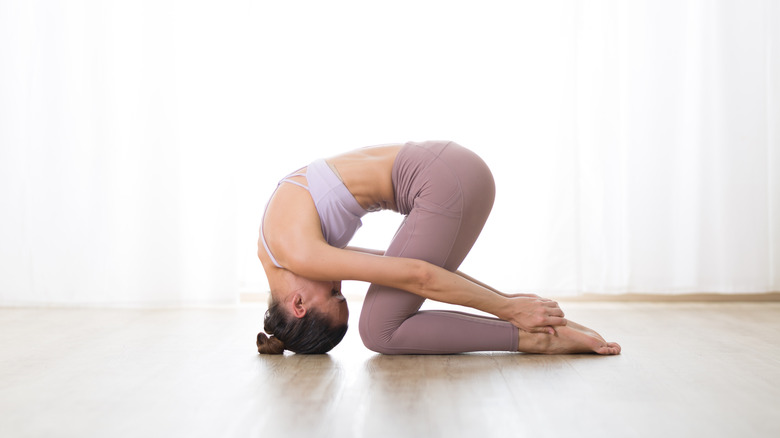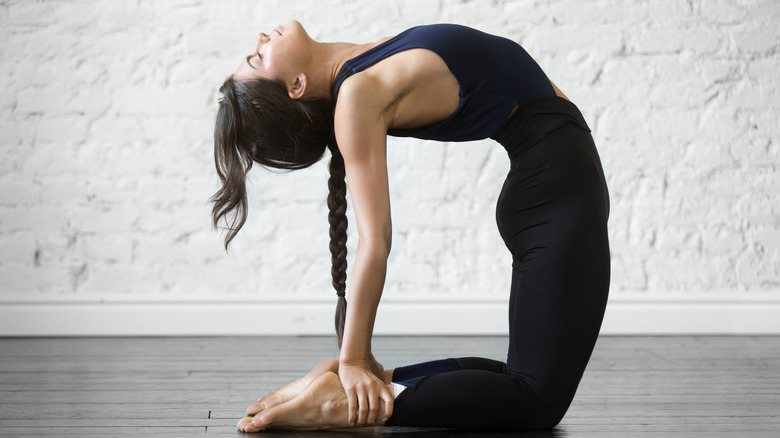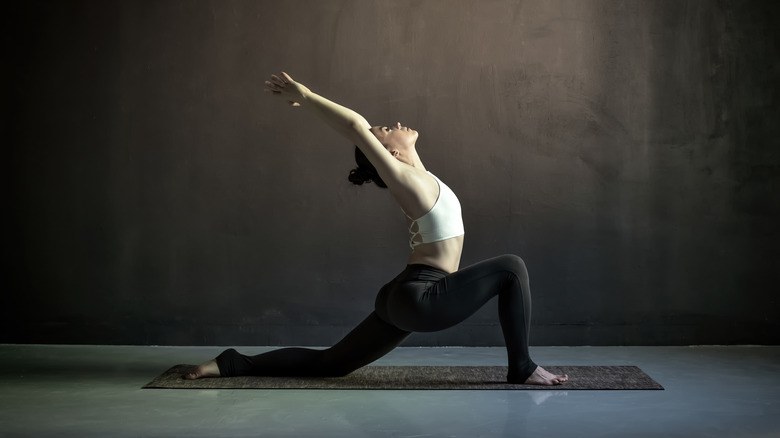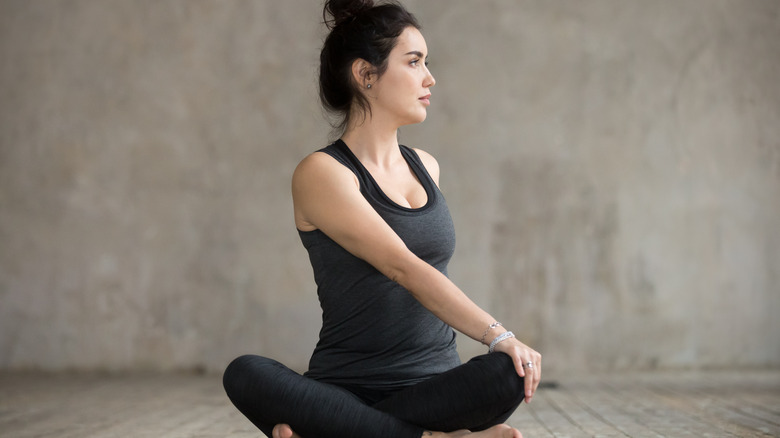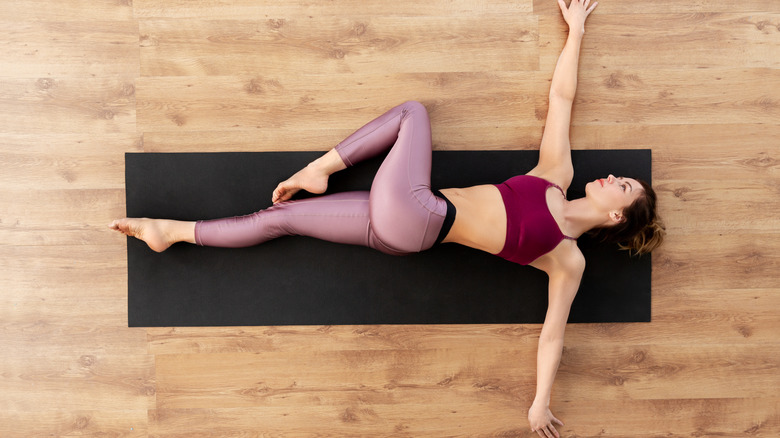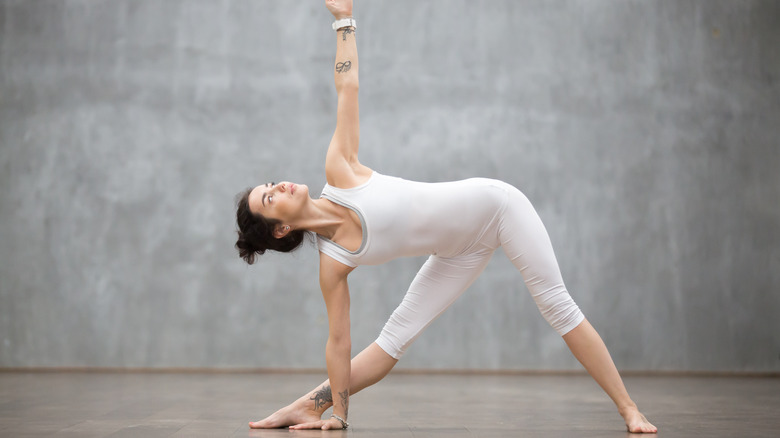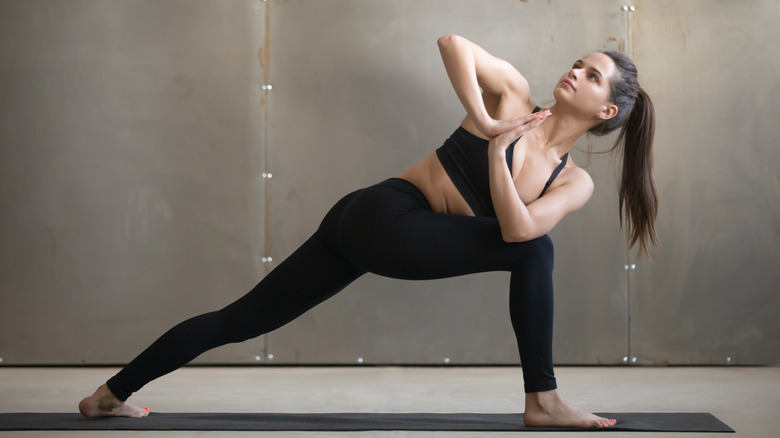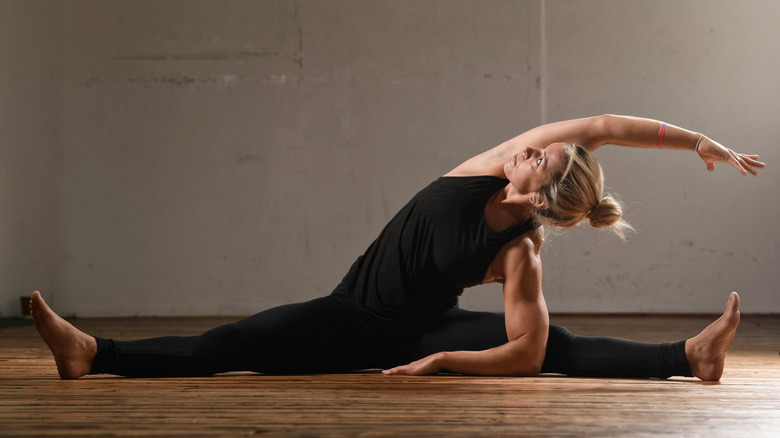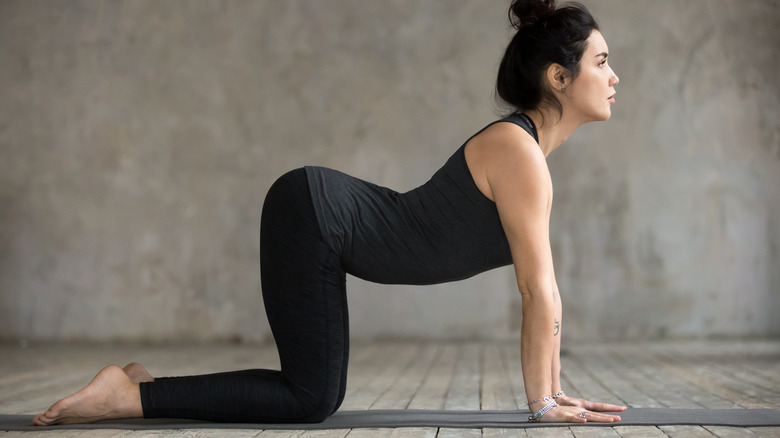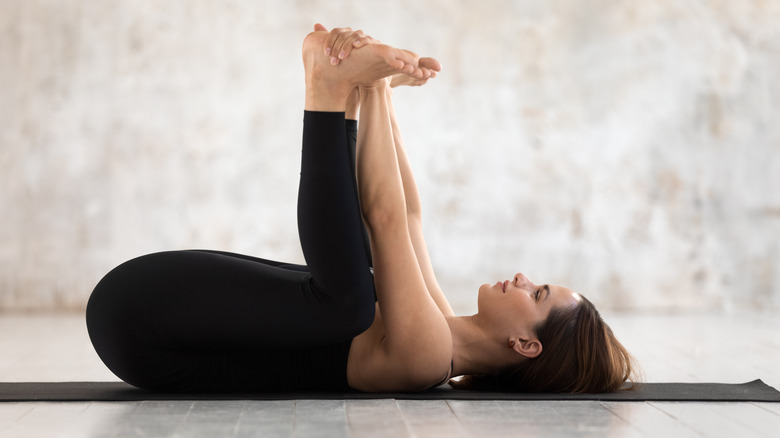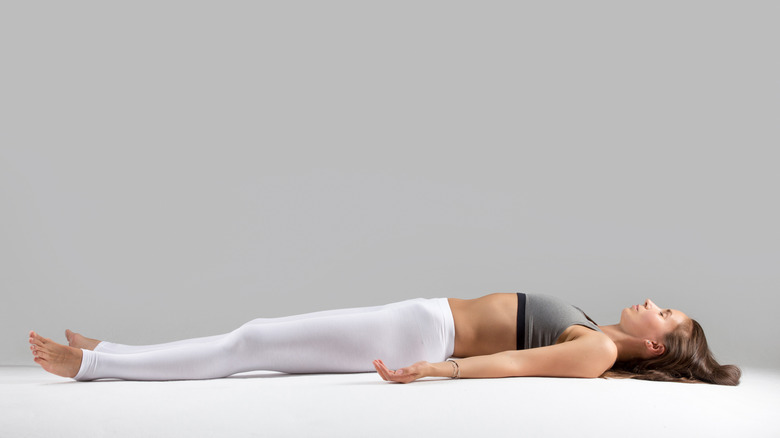15 Yoga Moves Perfect For Releasing WFH Tension
While working from home definitely has its benefits, it's not always a dream come true we imagine it to be. Yes, working from home means working from the comfort of your desk, sofa, or even bed — but what if these places aren't actually all that comfortable? If you work in poor conditions daily, you may find yourself dealing with things like back pain, eye strain, and even digestion issues. In fact, according to the UK's ONS, working from home has led to a significant increase in neck and back injuries.
If you have been struggling with those all-too-familiar twinges in your neck or lower back recently, we're here to help. We spoke to a few yoga teachers to find the best poses for easing that WFH tension. Try these poses during your next lunch break or after logging off for the day, and pretty soon, you should feel a lot more like your old self — even when you're working from home.
Child's pose (Balasana)
Child's pose is an easy restorative yoga pose that will help stretch out the spine and release any tension built up in the back, the glutes, or the shoulders, as one 2017 study showed. The pose can also help reduce stress and lower the heart rate, so if work becomes tense and worsens your pain, this calming pose may help. As another 2017 study showed, the pose can improve blood pressure and heart rate.
"Child's pose takes the pressure off your lower back by elongating and aligning the spine, which decompresses it and gives you a nice stretch," New York City-based yoga instructor Shanna Tyler told SELF in 2021.
Kneel on the ground with your knees together or apart, then walk your hands forward in front of you until your chest is resting on your knees and your forehead is resting on the floor. Hold and breathe into the stretch, trying to release any holding or clenching in the body.
Sphinx pose (Salamba Bhujangasana)
Sphinx pose is a great way to counter all the time you spend with rounded, hunched shoulders while working on the computer at home. The pose is a gentle backbend that helps to open the chest, heart, and shoulders while strengthening the upper back to prevent habitual rounding.
"Sphinx Pose is an excellent option for those who are beginners," Brandt Passalacqua, Founder, Director, and Lead Teacher at Breathing Deeply Yoga Therapy tells us at The List. "It's a gentle backbend that can help strengthen your spine and increase mobility in your back, both of which are important if you are seated for long periods while working from home. Sphinx Pose also stretches your chest, shoulders, and abdomen, which can help if they're feeling stiff. As with many yoga poses, it's also excellent for relieving stress, which may occur during work."
To perform the Sphinx pose, lie on your stomach, place your forearms parallel to the floor with your elbows directly under your shoulders and imagine you're gently pulling your forearms and your pelvis together. Your upper back should naturally open and arch away from the mat.
Bow pose (Dhanurasana)
If you tend to sit at your desk with a rounded spine, this intense backbend will help open up the front of your body and relieve the tension built up in the back body. Bow pose is a heart opener that will help to stretch the chest and shoulders while strengthening the postural muscles around the spine.
"Bow is an amazing way to really open everything up after a day spent hunched over at a desk," Louise Hoare, a London-based yoga teacher, tells us. "Be sure to really kick into your ankles and breathe into your heart space when you're in the pose to make it as expansive as possible."
To perform the bow pose, lie on your stomach, and bend your knees, sending your feet towards your glutes. Reach back and grab your ankles. On an inhale, kick your ankles into your palms and let your chest arch away from the floor. Hold for several breaths.
Forward fold (Uttanasana)
A simple forward fold is a wonderful way to release lower back tension that may have built up while sitting at your desk all day.
"On the physical front, this pose stretches the hamstrings, hips, and calves. A standing forward fold improves flexibility on the posterior [back] side of the body, which is so important for the amount of time we all tend to sit," yoga instructor Bethany Lyons, owner, and CEO of Lyons Den Power Yoga and Lyons Den Digital, told SELF. The pose can also help you with balance and posture. "The changing of visual cues and being upside down, along with changing your weight distribution, will improve the proprioception of the muscles around the joints of the lower extremities," Lyons said.
Stand with your feet hips distance apart and fold forwards from the hips. Keep a gentle bend in the knees, and try to imagine your spine releasing vertebrae by vertebrae as your head sinks closer and closer to the ground. As you do so, you should feel the muscles in your back body slowly opening up.
Rabbit pose (Shashankasana)
This is one of the best yoga poses for releasing tension and compression in the lower spine. It's a deep spine opener that can help you feel like you're opening up all of those little spaces between the vertebrae, making it the perfect antidote to a day at the computer.
"I love doing rabbit pose when my lower back feels uncomfortable after too much sitting and bad posture," Hoare says. "Try to imagine your spine opening up as you create a deeper and deeper curve in the posture. By the end, you should feel an inch or two taller!"
To try the rabbit pose at home, kneel with your knees hip-width apart. Grab the outsides of your heels and send the top of the head to the floor just in front of your knees. Try to round through the spine as you pull on your heels. You should feel your spine lengthening and stretching.
Camel pose (Ustrasana)
This pose is one of the most intense backbends commonly found in yoga classes. Camel pose is a deep heart opener that can help to re-align the spine after it's been rounded all day and, over time, can help to improve your spinal posture, especially if you spend a lot of time at a desk.
"When we work from home, we spend a lot of that time sitting. Our body curls forward, the shoulders and spine are rounded forward, constricting the lungs and impairing breathing," Libby Stevenson, head of yoga for Harley St. at Home, tells us. "Camel pose is the opposite to curling forward. It lifts and opens the chest, gives the lungs and digestive organs space and stretches both the spine and thigh muscles. Feels great after sitting!"
Get into camel pose from a kneeling position. Tuck your toes under and reach back to rest your hands on your ankles. Gently push your hips forward and chest up to increase the back bend. Hold for several breaths.
Crescent moon pose (Añjaneyāsana)
This yoga pose involves the whole body. It's invigorating, rejuvenating, and helps you really feel like your entire body is opening up — which is just what we all want after a long, cramped day in our home office.
"Crescent moon is a deep hip opener and back bend. It will stretch out those hip flexors that spend so much time contracted when you're sitting while also strengthening the back muscles for better posture at your desk," Hoare tells us.
To perform the Crescent Moon pose, begin kneeling. Bring one foot forwards into a lunge, keeping your back knee on the floor and your hips square to the front of the room. Bring your palms together into a prayer position at the chest. If you feel comfortable and stable, reach your arms up to the sky and slowly open your heart towards the sky in a gentle backbend.
Seated twist (Parivrtta Sukhasana)
This twist is the perfect way to bring some movement and flexibility into the spine. If you've been feeling stiff and creaky in the spine after a long day of work, try a simple seated twist.
"A good twist can really help with back pain by bringing fresh blood supply to the discs and the vertebrae," Hoare says. "A gentle seated twist is perfect as you can do it in between meetings without even leaving your desk."
To perform the pose, begin sitting cross-legged. Bring your right arm across to your left knee and position your left hand on the ground behind you. Push gently into the left hand to lengthen the spine, then pull gently on the knee with the right hand to spiral the spine, twisting towards the left. To increase the intensity of the twist, send your right leg out long in front of you, bring the sole of your left foot to the ground outside of your right leg, and hook your right elbow around the knee.
Revolved belly pose (Jathara Parivrttanasana)
If you sometimes feel like your spine needs a good crack, this pose can be an excellent way to open things up and reset the spinal alignment. It can also feel great in the chest, neck, and shoulders.
"Revolved Belly Pose is especially helpful if your back is feeling stiff or painful while working from home," says Passalacqua. "It can help to strengthen your core muscles, which support your body and facilitate good posture while you sit. The pose also stimulates your abdominal organs, improving digestion and circulation in your gut. Poor digestion and circulation can lead to poor posture and back pain."
To try this pose, lie on your back, bring one knee up to your chest, then drop that knee to the floor, twisting around your straightened leg. Send your arms out into a "T" and send the gaze in the same direction as the bent leg. Try to let your shoulders and glutes melt into the floor and let gravity deepen the twist.
Triangle pose (Trikonasana)
This standing posture isn't just good for stretching out stiff muscles; it's also great for building strength so that your WFH postures improve over time. This hopefully means less tension and pain in the long run.
"Triangle Pose is a great option for those who'd like a more advanced pose, though it can be modified for beginners as well," Passalacqua tells us. "As a standing pose, it's also more active, getting you on your feet and getting blood and oxygen circulating throughout your body after sitting for long periods at work. Another benefit of Triangle Pose is that it strengthens and stretches many different body parts, including your chest, back, abdomen, hips, thighs, and hamstrings."
Try a triangle pose, standing with your legs about twice as wide as your hips facing the side. Turn your front leg to face the front and raise your arms into a "T." Tilt your upper body over your front leg, keeping your torso in line with the side wall. Rest your bottom hand on your ankle, calf, or on the floor, and send your top arm straight up to the sky. As you breathe, try to lengthen both sides of the torso towards the front wall while keeping your torso as flat to the side wall as possible.
Revolved side angle pose (Parivrtta Parsvakonasana)
This intense side bend doesn't just get into the spine; it's a full-body pose that stretches and strengthens the legs, as well.
"This is a great pose for practitioners who are a little more experienced with their asanas," Hoare says. "It will help to strengthen the glutes and abs, which both play a really important role in good posture, while also giving you a deep, juicy twist through the spine, so it's perfect for people who work from home. One tip — be sure to keep the hips shining forwards as you twist."
You can begin the revolved side angle pose by getting into a lunge with your back toes tucked and your knee lifted. Bring the palms together at the heart in a prayer position. Send the opposite elbow to the outside of the bent knee. Push gently into the palms to twist over the leg.
Seated side stretch (Parsva Sukhasana)
If you feel like your whole torso needs to be stretched, not just the spine, this one's for you.
"We often spend a lot of time stretching our spines laterally in yoga with loads of forward folds and backbends — but sometimes, we forget about the side body," Hoare says. "A gentle seated side bend is ideal for bringing some breath and space into the intercostal muscles that line the ribs and can leave your spine feeling longer and better aligned."
Begin in a cross-legged position or with your legs stretched out to either side in a gentle straddle. Raise one arm to the sky and gently bend sideways away from the outstretched arm. Let the other arm or forearm rest on the floor to support you. Try to keep the torso in line with the wall in front of you by encouraging the top shoulder to open up towards the sky rather than folding inwards towards the floor.
Seated cat cow (Upavistha Bitilasana Marjaryasana)
If you've ever been to a yoga class, there's a good chance you've done cat-cow before. Traditionally, the pose involves arching and rounding the back while in an all-fours position while on the floor. However, you can also do the pose seated if you choose.
"This is probably my personal favorite stretch for my back," yoga teacher Shanna Tyler told SELF during an interview in 2021. "It allows for a nice flexion and extension of the spine, promotes mobility, and "it also helps to just relieve any tension in the lower back."
You can try out the position by simply sitting in a chair or cross-legged on the ground. Place your palms on your knees. On an inhale, arch through the spine, pulling gently with your palms. On an exhale, round through the spine, pushing away against your knees. Repeat several times, trying to feel each individual vertebrae.
Happy baby pose (Ananda Balasana)
Happy baby is a fun, simple pose that stretches the groin and helps to lengthen the lower spine.
"I love how this pose helps to open up my lower back," Hoare says. "It's a great one for easing stress and anxiety, too, so it's the perfect pose to try in a mid-day routine while you're working from home." Yoga Journal also points out that when executed correctly, the position can feel like a massage. "As you roll around side to side and back and forth in Happy Baby, it feels like you're getting a great massage. It will give your back and hips some extra love that they need and crave," the outlet reports.
Lie on your back and bring your knees to your chest. Then, send the soles of your feet towards the sky. Reach the palms to the insides of the feet. Gently pull the feet down, keeping the shoulders and lower back flush with the mat.
Corpse pose (Savasana)
No yoga class could really be considered complete without the traditional final pose, Savasana, or the corpse pose. While it's a simple pose in theory, it's a vital and important one after practicing, as it's the time when your body readjusts and recalibrates after all of your other poses. In short, it's the perfect time to reset for the rest of your day.
"This pose is what we call in yoga a restorative pose, which means just by being in the pose, it restores us by releasing tension from the body and quieting the mind," Stevenson tells us. "The body is stretched and open. Allowing the body to sink down into the mat after a day of work is bliss."
To get into the corpse pose, simply lie on your back, let your arms and legs splay out, close your eyes, and try to let everything go.
